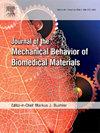Effects of surface morphology and chemical composition on friction properties of Xenopeltis hainanensis scales
IF 3.3
2区 医学
Q2 ENGINEERING, BIOMEDICAL
Journal of the Mechanical Behavior of Biomedical Materials
Pub Date : 2024-10-24
DOI:10.1016/j.jmbbm.2024.106786
引用次数: 0
Abstract
The scales of Xenopeltis hainanensis, a snake that can crawl in fields, valleys, and other places, can serve as inspiration for the design of scale-like bionic materials. We present a systematic morphological, microstructural, chemical, and mechanical analysis, including elastic modulus, hardness, and wear morphology of the scales to understand the friction basis for achieving the reptile requirements. At the surface level, a comb-like arrangement of microstructures on the ventral scales provides more surface area and reduces pressure. The separation of microstructures, along with the bending and delamination of collagen fibrils could contribute to energy dissipation, which helps prevent catastrophic failure at deeper structural levels. At the cross-sectional level, a greater thickness provides more distribution of stresses over a larger volume, reducing local deformation and increasing the resistance to damage. At the material level, the ventral scales show higher modulus (E = 384.65 ± 19.03 MPa, H = 58.67 ± 6.15 MPa) than other regions of snake scales, which is attributed to the increased thickness of the scales and the higher concentration of sulfur (S). The experimental results, combined with Energy-dispersive X-ray spectroscopy and SEM characterization, provide a complete picture of the fiction properties influenced by surface morphology and chemical composition during scratch extension of the Xenopeltis hainanensis scales.
表面形态和化学成分对海南鳞片摩擦特性的影响
海南蛇是一种能在田野、山谷等地爬行的蛇类,它的鳞片可以作为设计鳞片状仿生材料的灵感来源。我们对鳞片进行了系统的形态、微结构、化学和力学分析,包括弹性模量、硬度和磨损形态,以了解实现爬行动物要求的摩擦基础。在表面层面,腹侧鳞片上的梳状微结构排列提供了更多的表面积,并减少了压力。微结构的分离以及胶原纤维的弯曲和分层有助于消散能量,从而有助于防止深层结构的灾难性破坏。在横截面层面,厚度越大,应力在更大范围内的分布就越均匀,从而减少局部变形,提高抗破坏能力。在材料层面,腹侧鳞片的模量(E = 384.65 ± 19.03 兆帕,H = 58.67 ± 6.15 兆帕)高于蛇鳞的其他区域,这归因于鳞片厚度的增加和硫磺(S)浓度的提高。实验结果与能量色散 X 射线光谱学和扫描电镜表征相结合,全面展示了海南蛇鳞片在划痕扩展过程中受表面形态和化学成分影响的虚构特性。
本文章由计算机程序翻译,如有差异,请以英文原文为准。
求助全文
约1分钟内获得全文
求助全文
来源期刊

Journal of the Mechanical Behavior of Biomedical Materials
工程技术-材料科学:生物材料
CiteScore
7.20
自引率
7.70%
发文量
505
审稿时长
46 days
期刊介绍:
The Journal of the Mechanical Behavior of Biomedical Materials is concerned with the mechanical deformation, damage and failure under applied forces, of biological material (at the tissue, cellular and molecular levels) and of biomaterials, i.e. those materials which are designed to mimic or replace biological materials.
The primary focus of the journal is the synthesis of materials science, biology, and medical and dental science. Reports of fundamental scientific investigations are welcome, as are articles concerned with the practical application of materials in medical devices. Both experimental and theoretical work is of interest; theoretical papers will normally include comparison of predictions with experimental data, though we recognize that this may not always be appropriate. The journal also publishes technical notes concerned with emerging experimental or theoretical techniques, letters to the editor and, by invitation, review articles and papers describing existing techniques for the benefit of an interdisciplinary readership.
 求助内容:
求助内容: 应助结果提醒方式:
应助结果提醒方式:


